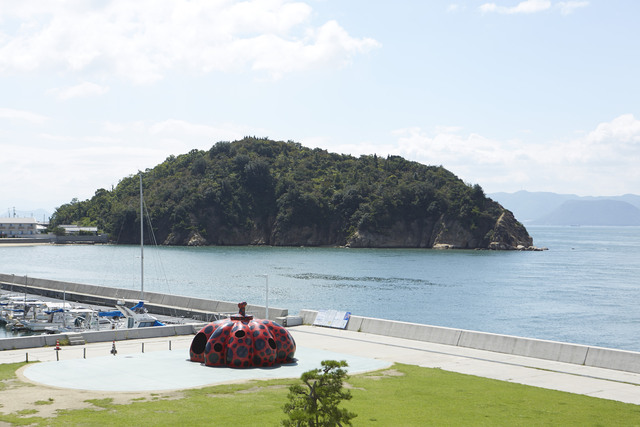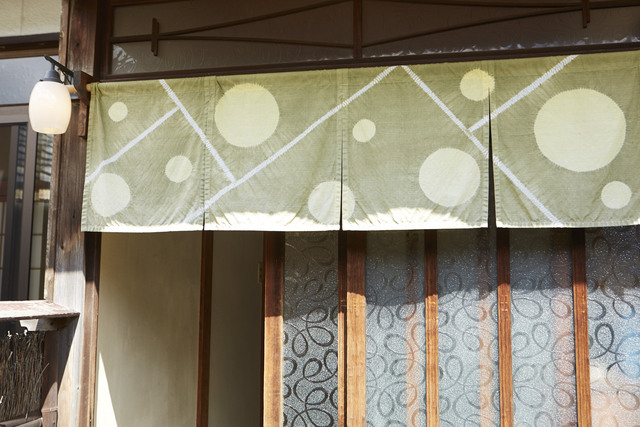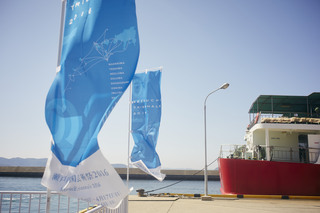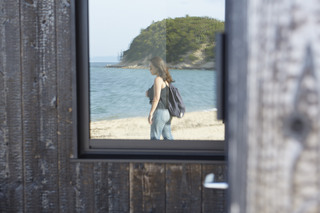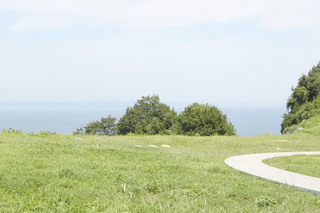In Naoshima, you will find many artworks displayed outside museums and buildings, in addition to the two huge famous polka-dotted pumpkins. It is a wonderful experience to view the outdoor artworks here, harmonized with the background scenery of the islands in the Seto Inland Sea, turning the entire island into an open-air art gallery. You will be impressed by how these artworks alter familiar scenes into an entirely different and new view. In addition to the finished artworks, many other works have been created by artists following their arrival on the island and being inspired by the environment. Not until you see them for yourself can you fully experience the unique nature of these outdoor exhibitions, the views that the artworks and the surrounding landscape generate together.
The area around the Benesse Art Site includes a large number of outdoor art pieces. Each of the artworks has naturally become part of its surroundings – take care therefore to not miss out on any. If you want to make sure you see everything, read up on information about the artworks and create a viewing schedule beforehand.
1. OUTDOOR EXHIBITIONS AT BENESSE ART SITE
Areas around the Benesse Art Site situated in the southern part of Naoshima are blessed with the stunning spectacle of Setonaikai National Park. The best way to enjoy artworks displayed in this area is to walk at a slow pace. It takes about 10-15 minutes on foot from the Tsutsuji-sou bus stop to Benesse House Museum, from Benesse House Museum to Lee Ufan Museum, and from Lee Ufan Museum to the Chichu Museum, respectively. However, this is the minimum travelling time – you may need to take into account extra time to thoroughly appreciate the exhibitions and for strolling down to the beach to view additional artworks.
A free shuttle bus is available every 15-30 minutes between Benesse House Museum, Lee Ufan Museum and Chichu Museum, but you need to walk from each bus stop to view outdoor exhibitions. Rather than taking a shuttle bus, a walk along the coast and up the hills is recommended while appreciating the artworks scattered around the area. This way, you can experience both the nature and the artworks of Naoshima up close.
Be aware that with the exception of guests who stay at the Benesse Art Site, vehicles including cars and bicycles are not allowed to enter the premise. You can park your car in the parking lot at Tsutsuji-sou; from here, you can walk or take a shuttle bus to your destination. If you have a bicycle, you can park it at the Chichu Museum ticket center; alternatively, there is bicycle parking near the east gate of the Benesse Art Site.
You should also be aware that the area surrounding the Benesse Art Site does not make provision for having meals or coffee, except at the café that is open to museum visitors. Prepare beverages for yourself in advance, as it may take a long time to view the open-air artworks, which at the same time requires you to travel on foot.
2. OUTDOOR EXHIBITIONS AT MIYANOURA PORT
The first thing you will see on your arrival at the Miyanoura ferry terminal may be a huge red pumpkin, created by Yayoi Kusama. The pumpkin is popular among tourists from around the world and deserving of representing the art-scaped island. However, it is not the only artwork displayed at Miyanoura Port; there is much more to see in the area.
Directly in front of the boat slip is the Naoshima ferry terminal, the unique architecture of which was designed SAANA. The artwork “Bunraku Puppet” is situated close to the Yayoi Kusama’s red pumpkin, another eye-catching artwork that is lit in rainbow colors at night. There is also the “I Love Yu Bathhouse”, a two-minute walk from Miyanoura Port, worth visiting if only to see what it looks like. What the artworks in Miyanoura have in common is that they exhibit different aspects during the day and night. Don’t forget the outdoor art in Miyanoura, an area that has gradually developed into a lively downtown on the island. Naoshima Pavilion, completed in March 2016 on the shore across the red pumpkin, is one of the newly created artworks that form part of the Setouchi Triennale.
3. OUTDOOR EXHIBITIONS IN HONMURA AREA
Although there is no specific outdoor art in the Honmura area (where the Art House Project is situated), the area includes local homes built according to traditional architecture from the Edo period. The houses are made of smoked cedar boards, their impressive black color evoking the old days of Japan, making it a perfect location for you to enjoy walking walk in. The Art House Project provides opportunities to local residents for starting new projects, where they put up “noren” and “yagoh” in front of their homes. This has made the Honmura area even more artistic, attracting visitors with its nostalgic atmosphere.
Noren: a short, split curtain hung in front of a store entrance that serves as a sunshade.
Yagoh: an individually-given name to a home that represents its family or a clan.
Yagoh: an individually-given name to a home that represents its family or a clan.
Naoshima has always been open to art, and is highly receptive to new ideas, even before the Benesse Corporation launched its Art Project on the island. Naoshima Elementary School and the town hall, situated a short distance from the Art Project, were both designed by a renowned architect, and stand out from other buildings for their architectural creativity. In addition, the ingenious Naoshima Hall was completed as part of the Art Project. A new passenger ferry terminal is also under construction and due for completion in the summer of 2016.
All of these architectural projects are well worth visiting as something you won’t see or experience anywhere else. It’s also worth noting that Ando Tadao Museum is located in Honmura, the artist's eighth completed work in Naoshima, and where you can experience the essence of Ando’s architectural work.
20 records
 FIND SHIKOKU
FIND SHIKOKU






